Mysteries of the Box
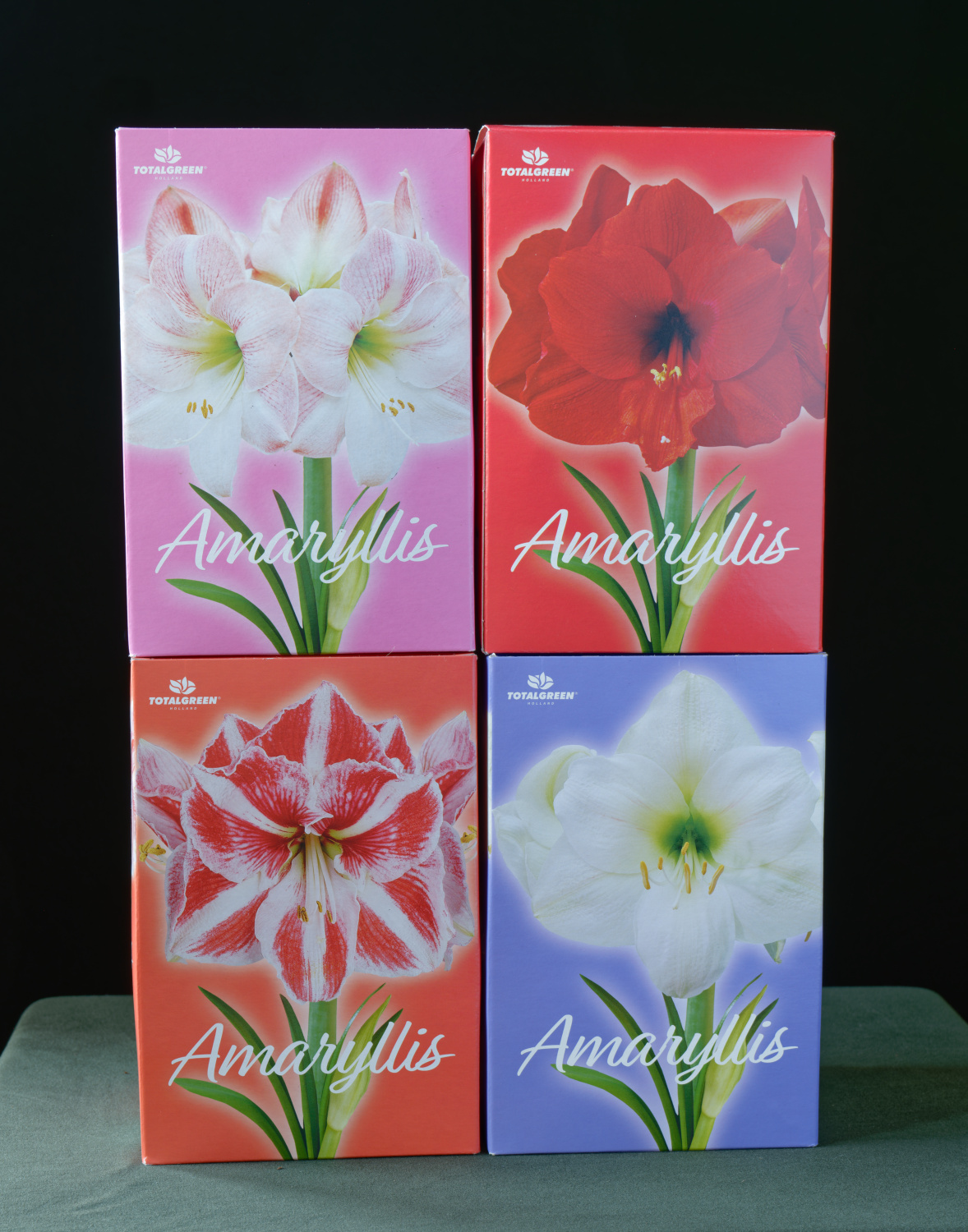
Just as the amaryllis season was going full steam, and bulb purchasing seemed to be in the rear view mirror, something made Emaryllis take a second look at these kits. Passed over since at least early October at our usual local grocer, these branded kits have been featured on these pages before, and Emaryllis felt it would just be plain lazy to grab these with little intention. Instead, the decision was made to obtain three very different kits in terms of variety of type (expired cultivar, double, and single-flowered). In the meantime, each visit to the grocery store saw the kits selling fairly well, with fewer and fewer on display over time. They were well priced at $8 each, and never went on sale that we noticed. Then, on the last day of December 2023, they went on sale for $5 each, a veritable bargain. E notified a friend by texting a photo of the few boxes left alongside the enticing price tag. Said friend later texted a photo of a kit he opened up at his local outlet. In order to show us the expected…that the kit had flowered out within the box?
Yes, and no. It’s great to have fellow plant peeps out there as scouts! He knew that was seen inside the box was not ‘Apple Blossom’, noting the raspberry coloration, starry shape and the picotee edge. Within an hour Emaryllis had arrived at the closest branch of the grocery store chain, where several kits were available. Only three were of the light pink/ “Apple Blossom” type. Peering inside the cartons yielded sights only marginally more encouraging than a bloomed out, and/or dried up scape. One box (and some to the other color boxes) indeed contained bulbs that had long bloomed within the box, then withered. But two of them were more interesting. One had a very long, curled scape, but it appeared intact. The other showed a shorter, more reasonable scape with minor curl. Both were promptly purchased. Why would Emaryllis make the decision to buy these “less than fresh” kits?
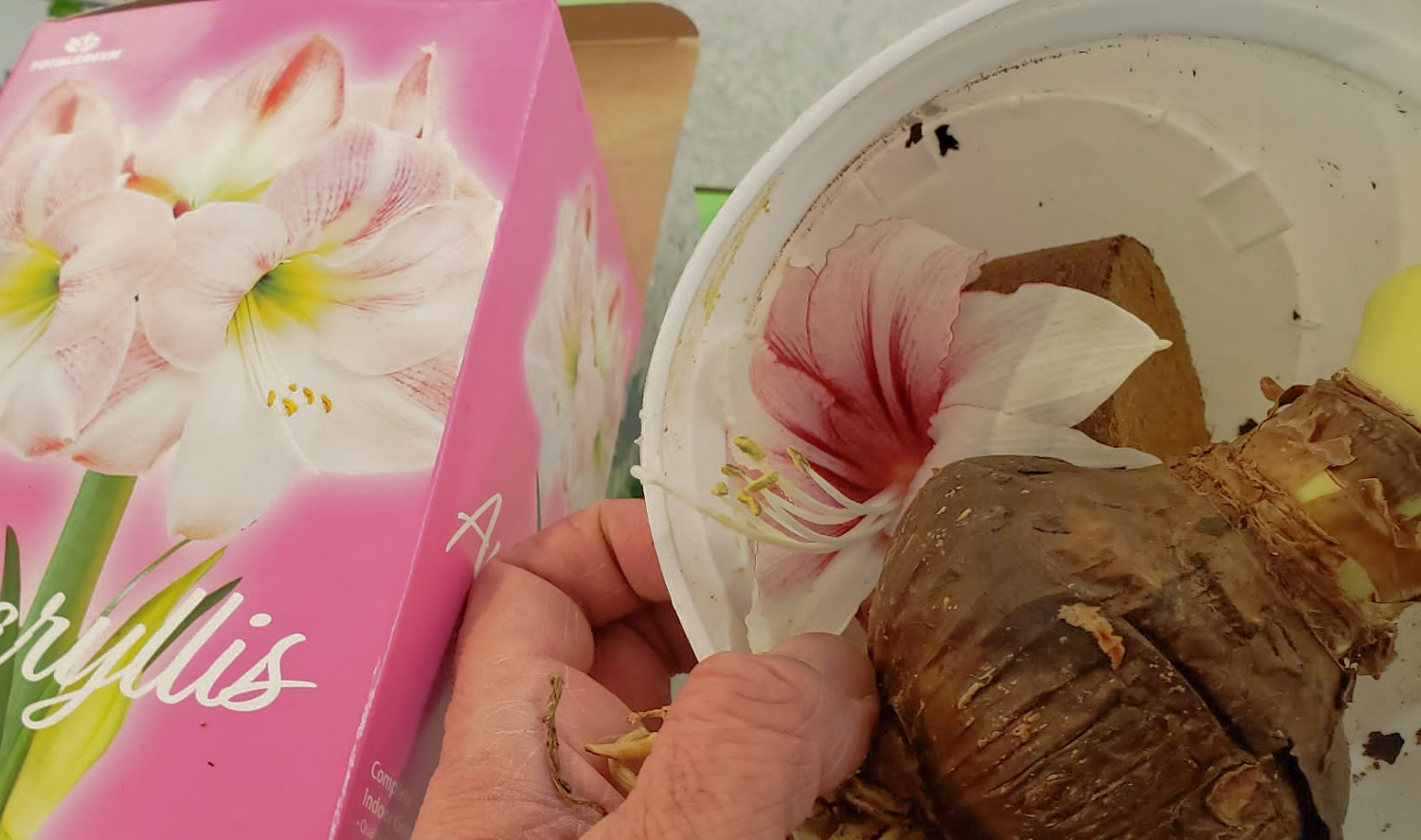
What we call box kits are shorthand for gift box kits in the trade. These are meant to be purchased as gifts for Christmas in particular. Buying these during after Christmas sales is a big gamble. The poor, long trapped amaryllis above had performed its holiday magic inside of a box, unseen and unappreciated until it was sadly too late. But that one flower is still remarkably beautiful, and even more than that, it is intriguing and mysterious. We can’t put a name to it.
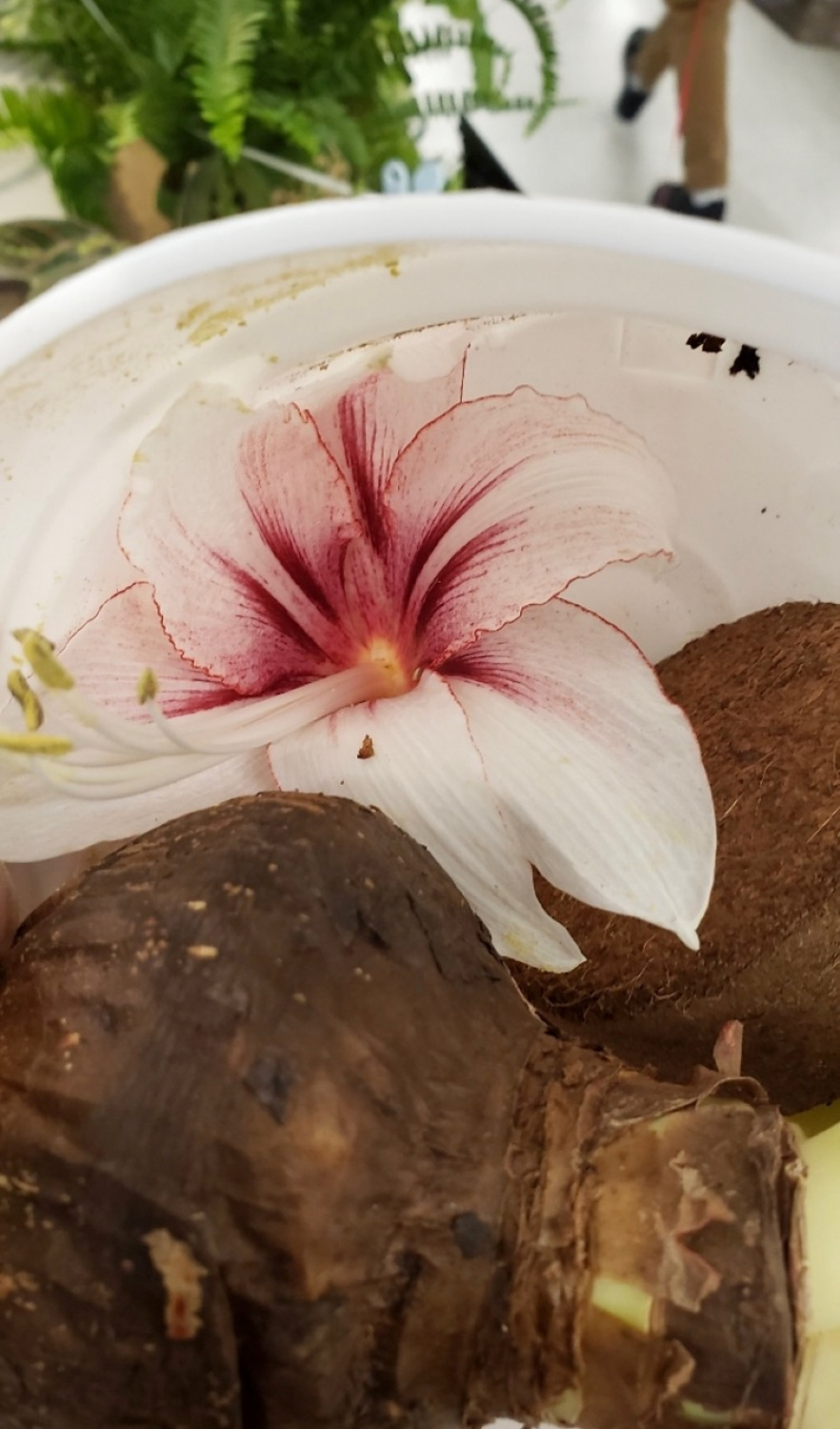
Israeli firm Saad-Assaf is the presumed supplier of these bulbs. They certainly do grow ‘Apple Blossom’ in large quantities. While the other kits look more generic, the boxes containing our raspberry-brushed mystery clearly show a photo of ‘Apple Blossom’. So why not call out that name on these kits? That’s easy; supplies are not guaranteed in the world of live crop production. Some years they may see a crop failure, or just too few were grown to fulfill orders placed months prior. So, why not leave some wiggle room? Anything even vaguely resembling the photo on the box will do, and many people will have recycled the carton before bloom time. No guarantee of variety means no returns for that reason later.

What got Emaryllis so excited was that the identity of the flower wasn’t coming instantly to mind. Identifying amaryllis flowers is kind of our thing here. Over the next two days, more kits from various branches of our local grocery store chain were purchased. By the morning of January the 2nd, a total of six box kits were purchased; three “Apple Blossom” and for good measure, one each red, white, and striped. Peering through many cartons revealed all sorts of horrors, and a few pleasant surprises. Surprising in their inconsistency, a few showed no signs of growth, or just manageable sprouting in addition to the many completely bloomed and dried up. Some had made two scapes, amazing for such small bulbs. Let’s see what we ended up with.
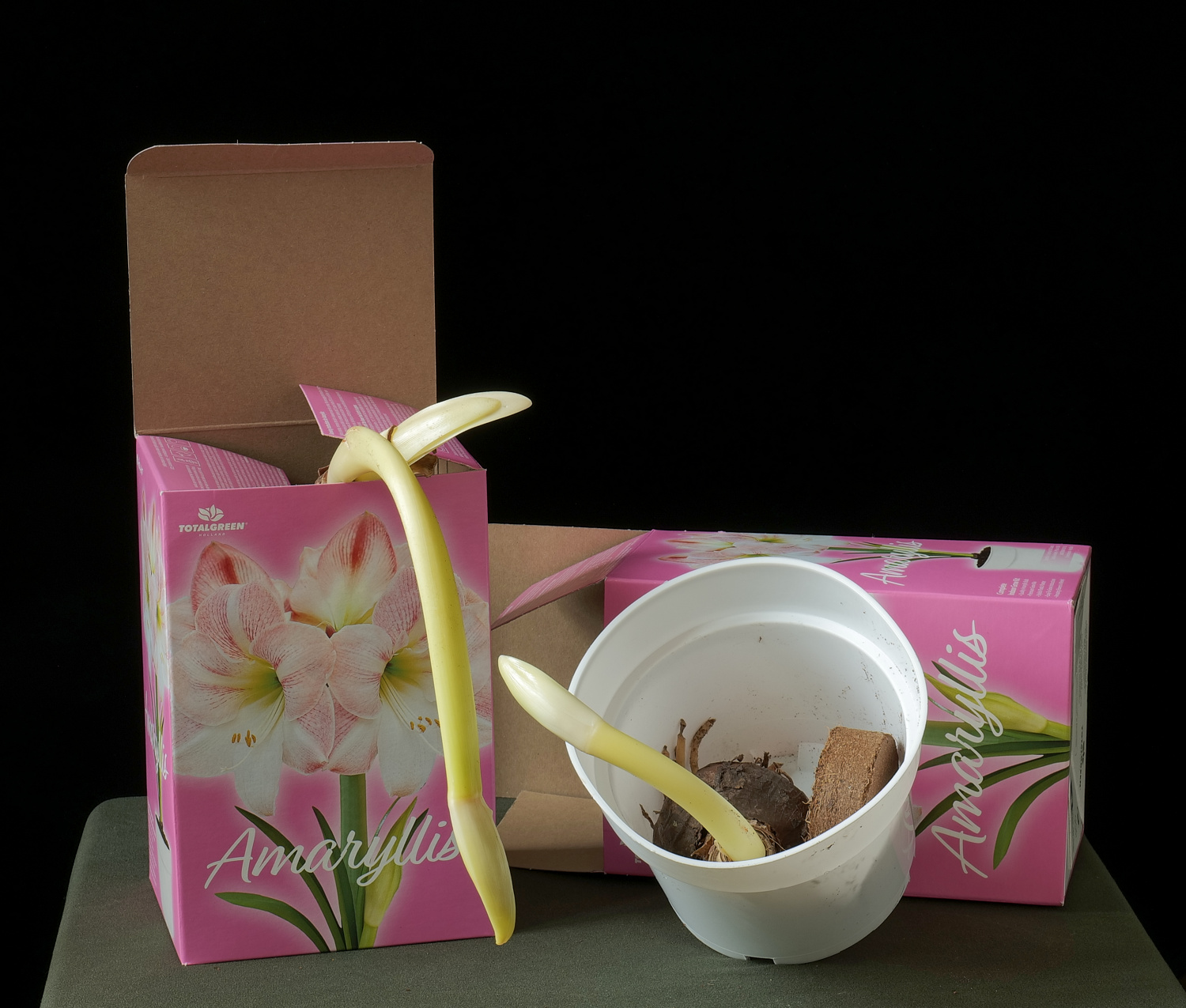
These two opened boxes yielded one pleasant surprise. The roots were surprisingly fleshy. Could this mean that as late as they are to getting the horticultural help they need, that they will be able to show us just how resilient amaryllises can be?
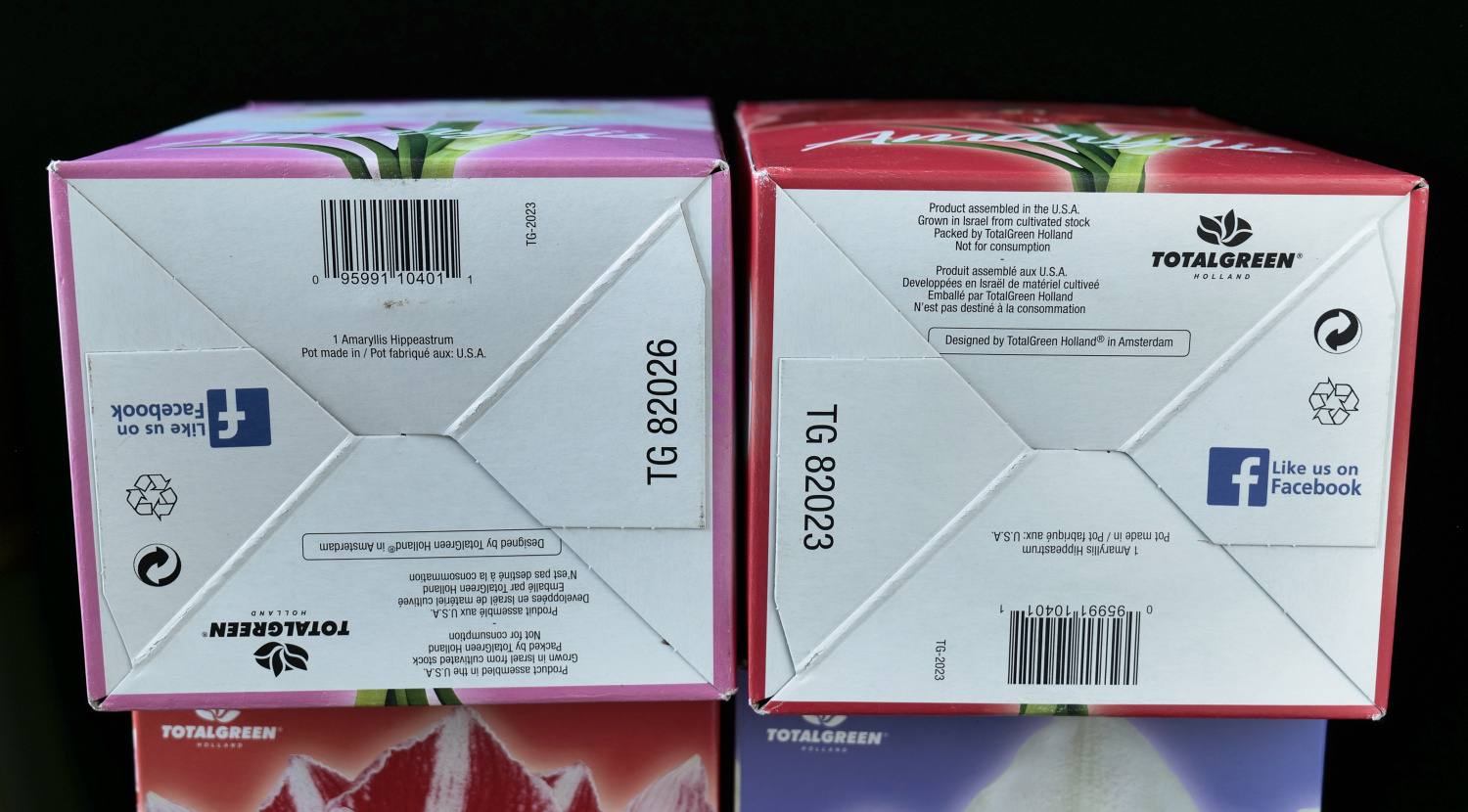
Why is the country of origin so interesting? There is only one Israeli company of any note producing Hippeastrum hybrids on a large scale, and that is Saad-Assaf. While they do produce the three “bigees” of the industry, including ‘Apple Blossom’ as shown on the carton, they produce many more interesting varieties. In 2015 we bought a box showing an image of ‘Opal Star’ that flowered as the amazing ‘Ruby Star’, an in-house substitution. If they are not putting ‘Apple Blossom’ in the box, which of their other cultivars might they use? A visit to their website shows us the common “open stock” varieties, their own currently produced selections, and a third page of “up coming” hybrids that are presumably being grown for future introduction. Combing these galleries yields two decent guesses, with some room for mystery. Could these be the excellent ‘Glee’? It has the picotee edge seen in the open box above, but the nature of the colorful brushing seems more raspberry than deep red. A new cultivar ‘Geisha’ also looks possible. It has a white background, and raspberry brushamarks, but no picotee edge in sight. Emaryllis loves this game! Perhaps blooming in good light, with roots functioning will end up showing us that they are the readily available ‘Glee’. But the question, the mystery is still there for now. The ultimate hope? That these are one of the company’s own hybrids not yet shown on their site, in early production. This of course has Emaryllis salivating.
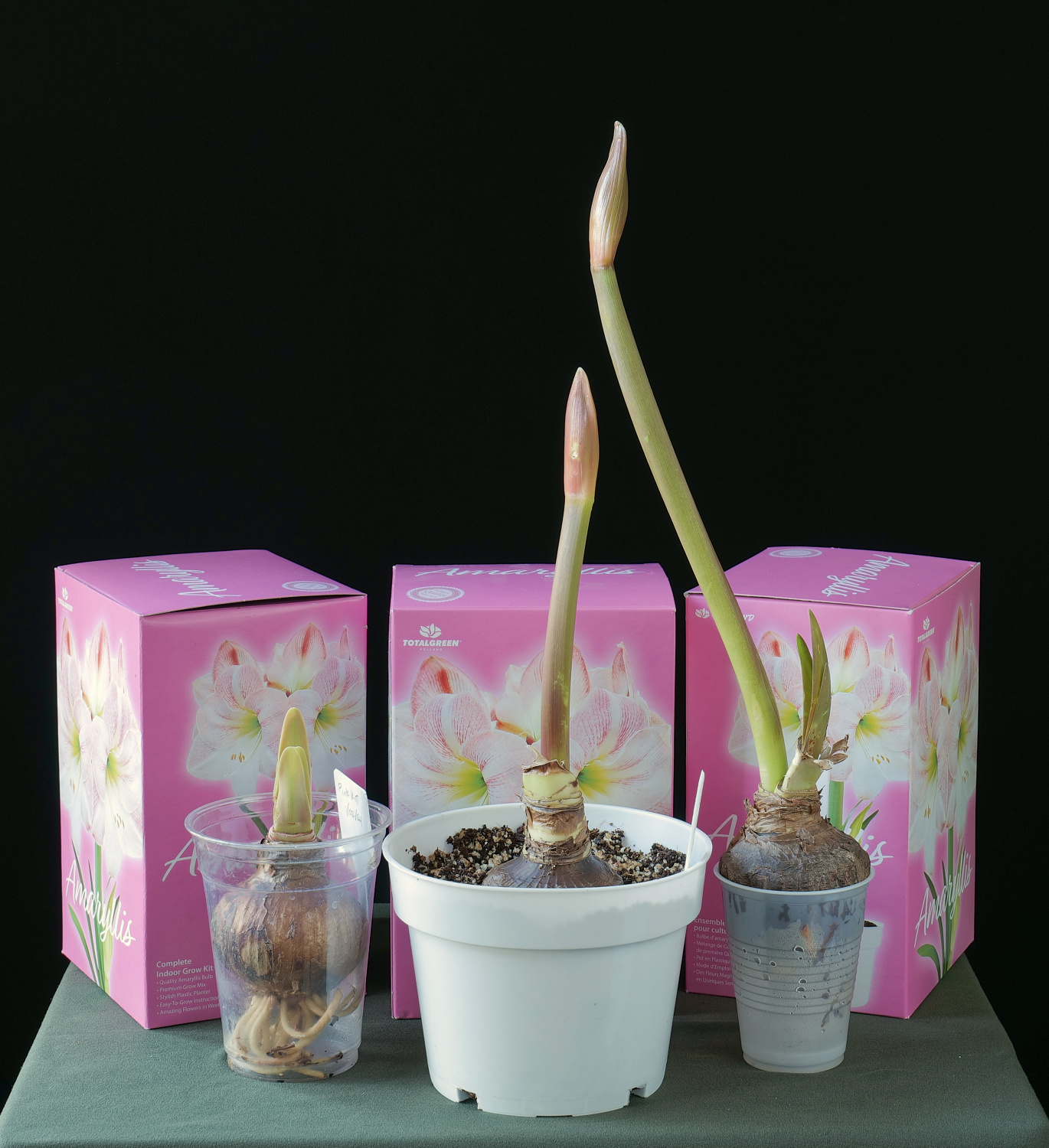
While we went through the trouble to cut four drainage holes into one of the white pots, it was deemed too large considering both bulb size and the paltry amount of coconut coir that the disc expanded into. To address the shortfall of volume, we made up the correct amount by simply adding an aerating aggregate, in this case, perlite. This should insure that being in plastic won’t allow the media stay oversaturated if watered too much, the aeration is now built in to the medium. What about the other two? Why are they in cups, suspended over moisture saturated air? Read on.
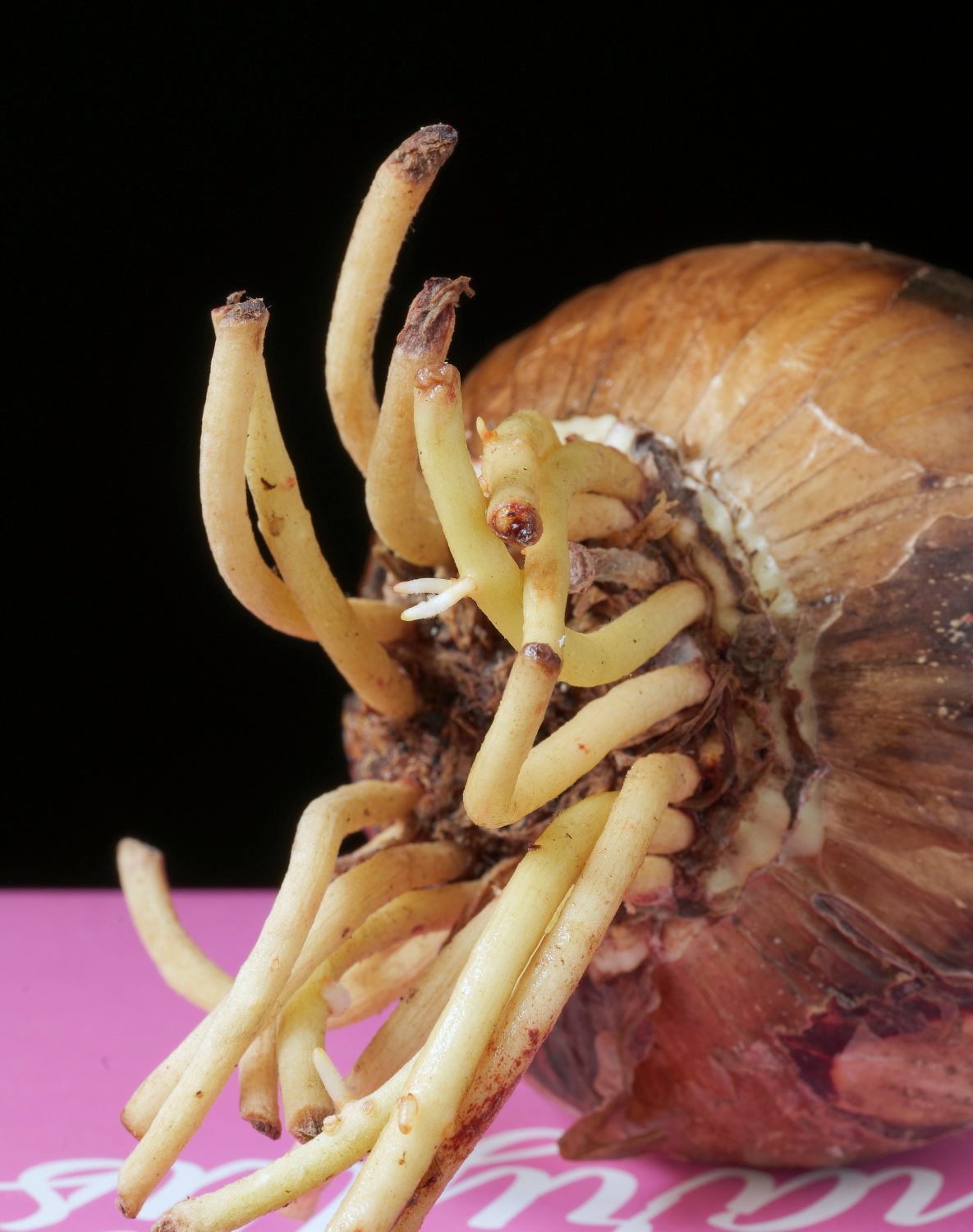
The three bulbs were quite small at 22-24 cm circumference. The tallest be-scaped individual was 23 cm and quite soft to the feel. Several layers of dry tunic were noted, as they dried up from the outermost ones in, as they remained helplessly trapped for months. The box retained enough humidity however, that the roots were quite good. The haircut that they received doesn’t matter so much. Suspending them in plastic cups into which a spray of water had been delivered, yielded root production in just three days! This is what happens after potting and watering, so long as the roots aren’t too wet, or too cold. Unlike the waxed bulbs that continue to be sold, these roots can start rehydrating the bulb itself, and hopefully fuel a better flowering.
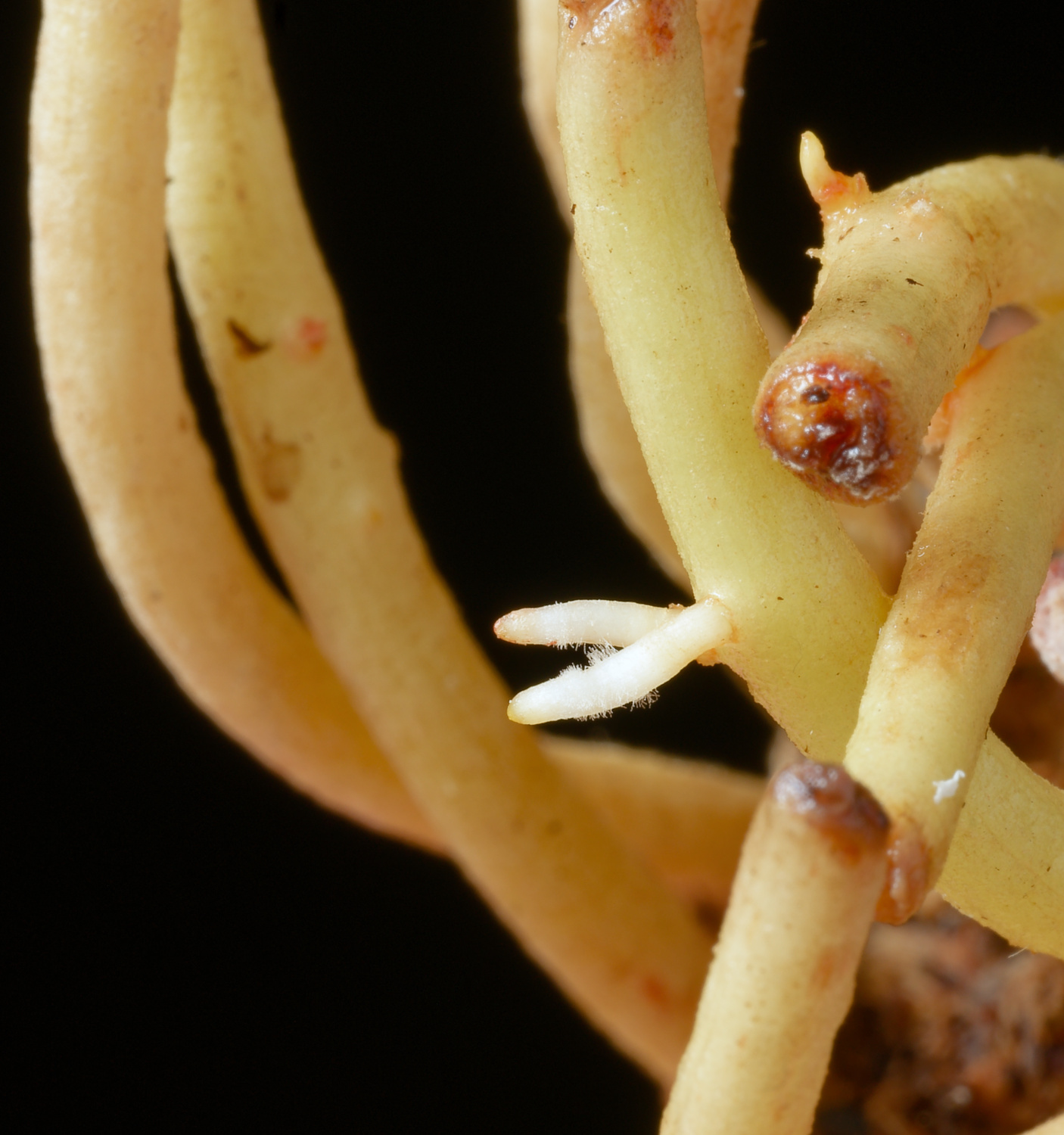
The two bulbs with roots suspended in a terrarium-like plastic cups for a few days show us what it takes to yield a decent performance after a long period of curing and storage. When you are able to select bulbs by examine them yourself, roots are one of the most critical things to look for. While even rootless bare-bottom bulbs will eventually produce new roots from the bottom of the basal plate, they may be just starting that process as the bulb is blooming. This can lead to potential tipping of the plant itself on its wobbly bulb, but also stunted flowering strictly at the expense of the bulb’s reserve moisture. Smaller, shorter-lived flowers, often with premature pollen drop are common in these cases.
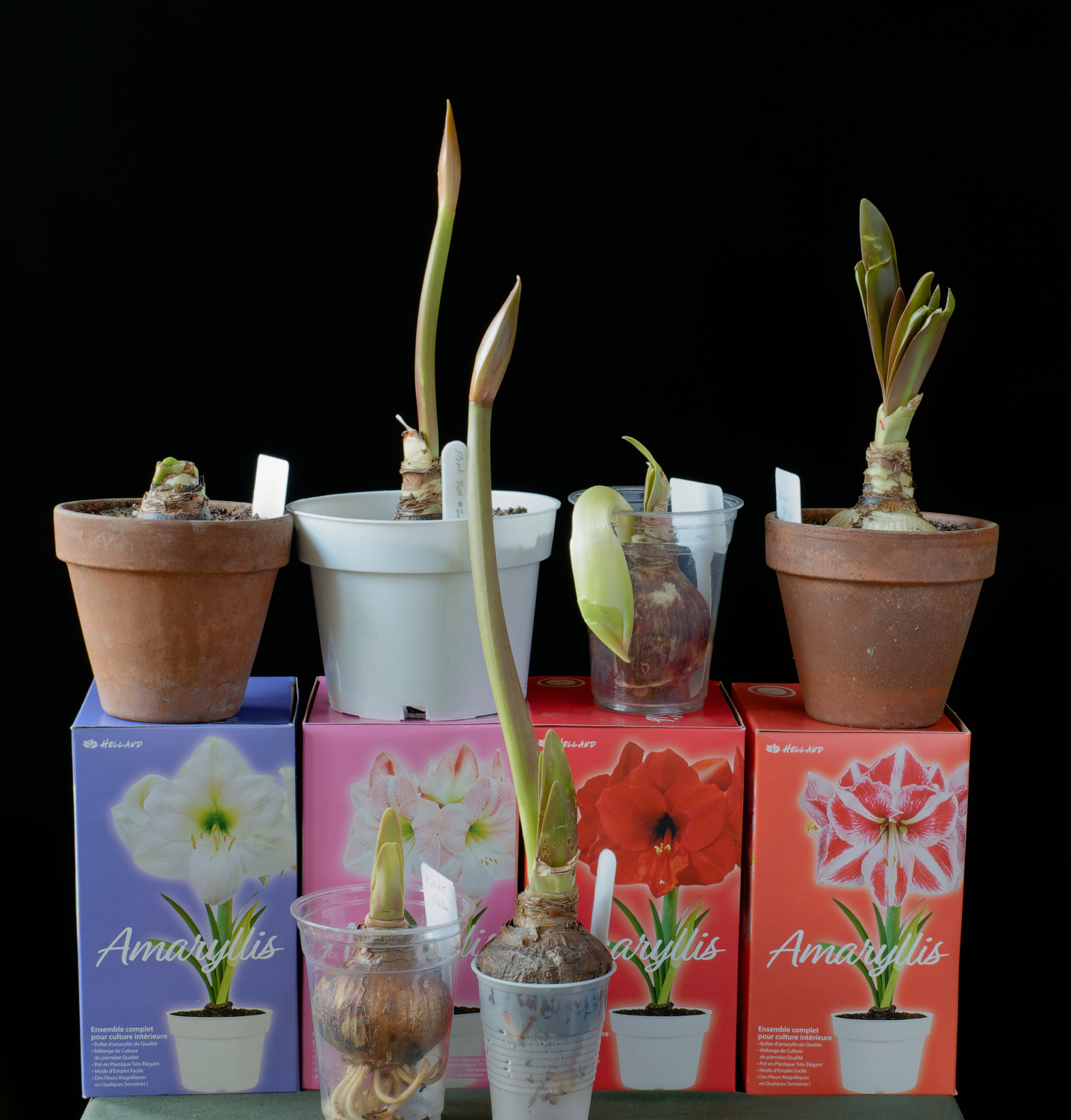
The white kit above yielded a 22 cm bulb with a few live roots, no growth, and some blackened leaf tips that were cleaned up. It was potted in E’s own mix, in a terracotta pot deemed size appropriate. This one looks like it will try our patience. The three “Apple Blossom” types all had surprisingly good roots. One was potted as shown, the other two will go into standard clay pots as with the others. The red kit is the saddest of all. A weak, curved scape has emerged along with some stubby leaves. The tiny, 22 cm bulb has no roots whatsoever. Suspending it in a makeshift terrarium did not yield any root formation after several days. It was potted regardless. The striped box kit also has a small and somewhat squishy (dehydrated squishy, not wet squishy!) 22 cm bulb, but the roots were quite good. A tussock of leaves was emerging and partly damaged in transit, but if it musters a scape (or two!?) it will have what it needs for a good show. The identities? Who knows. We have seem many kits with Israel origin bulbs with mislabeling issues. These Dutch branded “world kits” are assembled here in the U.S., with coir from India or Sri Lanka, bulb from Israel, and pot from U.S.A. Btw, we do know how to make pots with drainage holes here. How much cheaper can these drainless versions be? Only the American supplier and the Dutch company selling these kits knows.
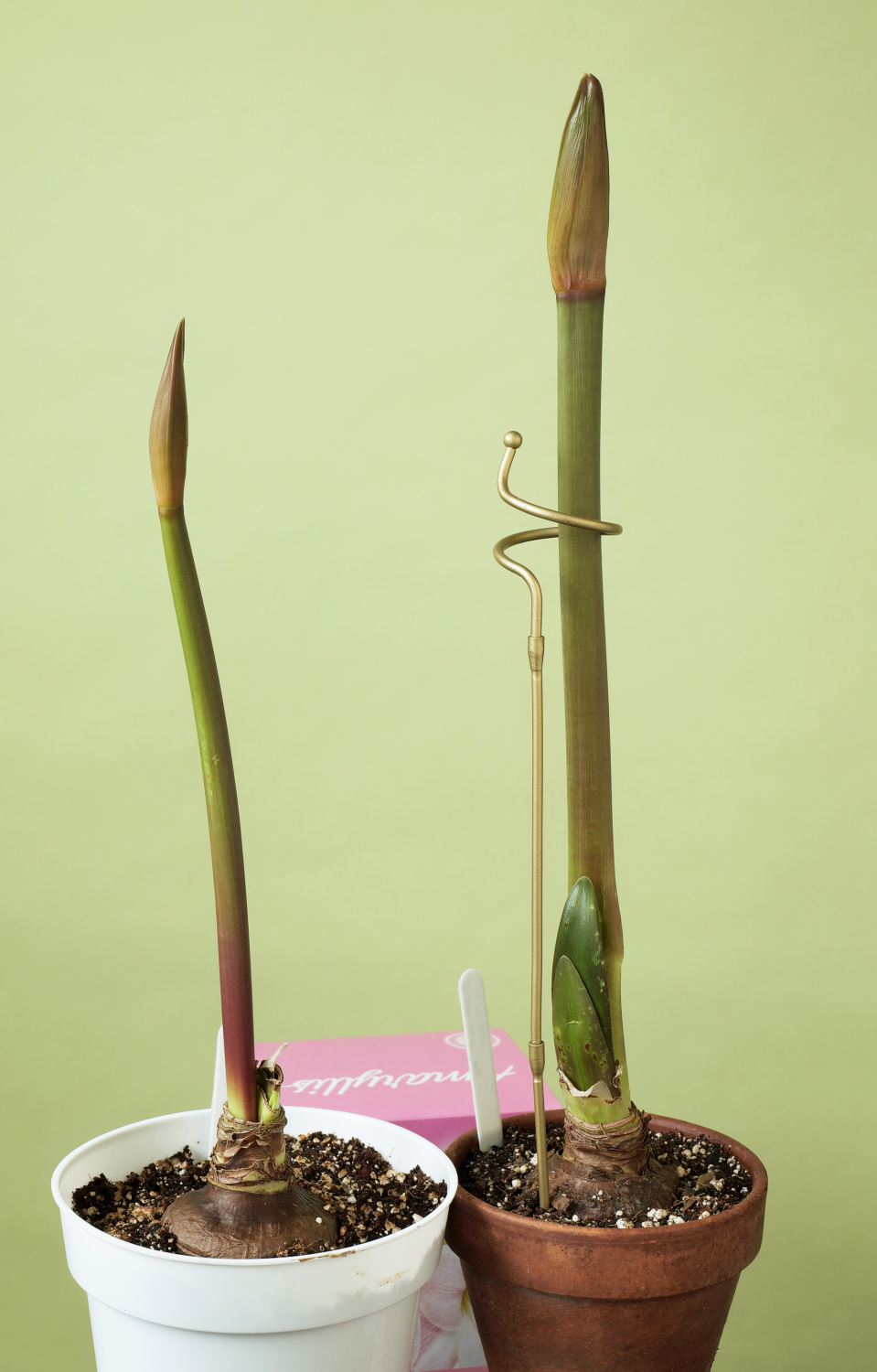
The thin, colorful scapes of the two most developed bulbs are the first clue to the question of whether these are actually ‘Apple Blossom’. They are not. That cultivar has thick, pale green scapes with a waxy bloom coating them. Neither of these is light green; both are dark and the spathe shielding the buds has some caramel rose tones. One has strong purplish pigmentation at the base. Now, the question is not rather they will be the clone photographed above, or ‘Apple Blossom’, but rather even these two examples are indeed two different hybrids. They are developing quickly, so we will know the answer in several days. Emaryllis is even more intrigued. Then, on the 10th of January, while innocently entering the local grocer for food only (we swear), the siren song of sale pricing gripped E once again. Amaryllis Anonymous should have been contacted for certain, but the addiction to bargains and amarylli are too much. We cave.

As if $5 kits weren’t enticing enough, now the dwindling supply of these was marked down to a mere pittance. At only $3 each. E furtively opens the last cartons to find any bulbs with even a hint of promise. Two more kits of the “Apple Blossom” sort are procured alongside essential food products. Now we are up to 5 of these kits, plus the 3 others. But hey, Emaryllis paid $35 for one individual bulb (‘Pink Beauty’) this season, so we have some sort of rationalization. Truly, this is a sickness. Fortunately, an affordable one in this case.
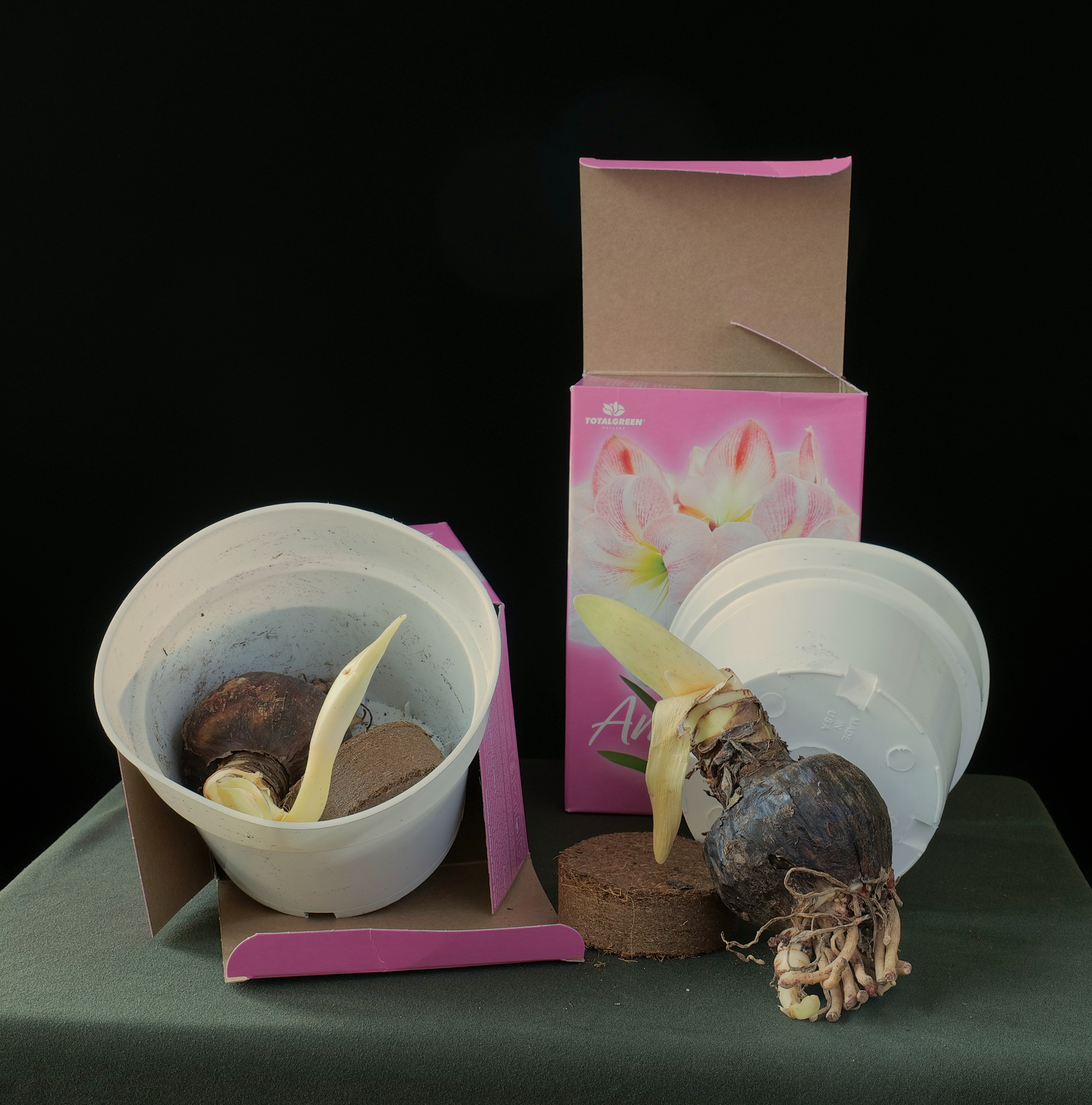
These were the best two kits left at one supermarket. One has a reasonably elongated but undamaged scape. The other has made a few limp, pale leaves. It could be worse.
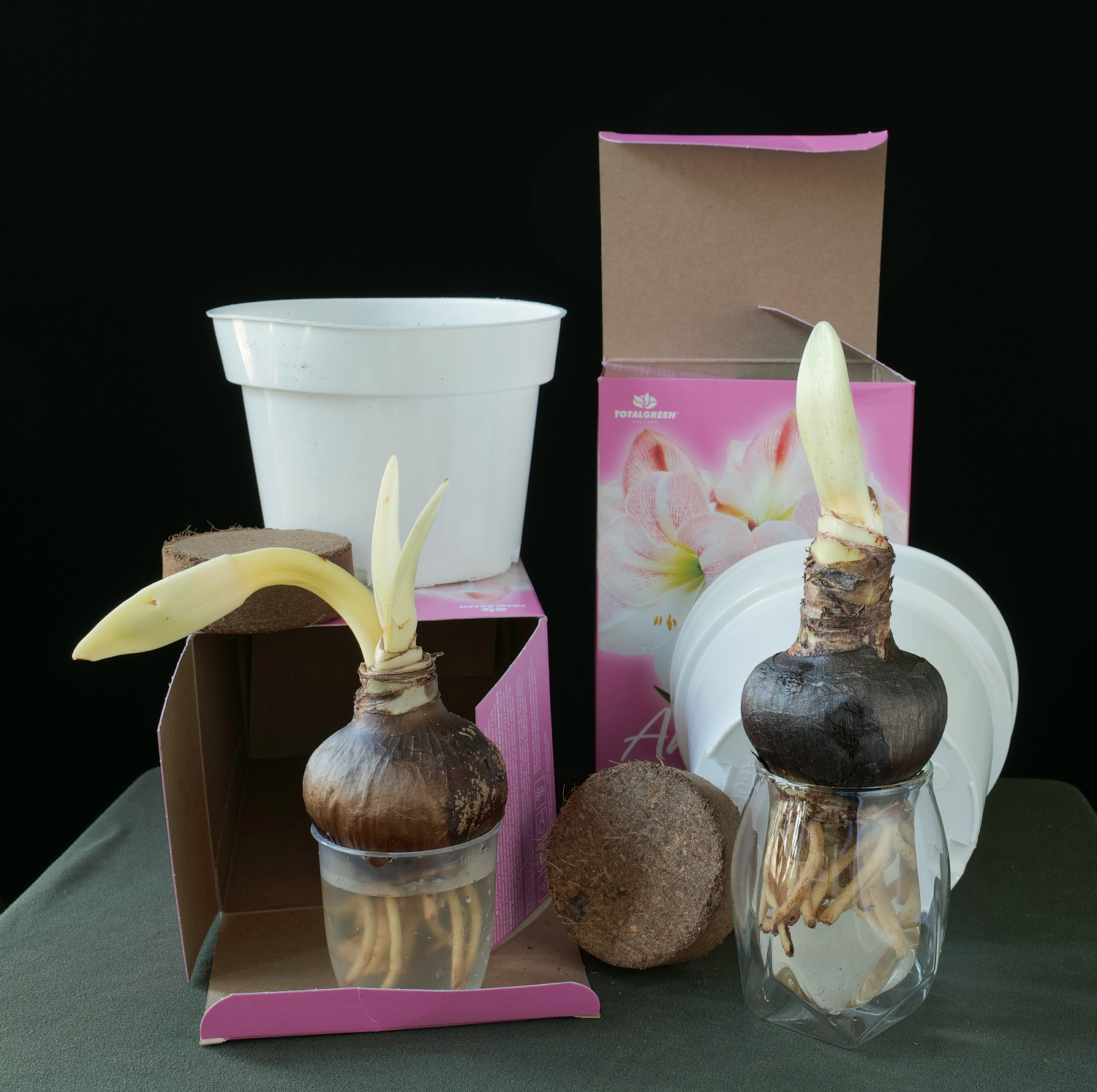
The latest pair of bargain bulbs actually do show some promise, in the form of fleshy roots. They are initially soaked in lukewarm water. At night the water is dumped out, and just a trace is left, forming a terrarium like chamber of 100% humidity. In less than two days, new rootlets emerge, and by the third day, they are potted up. The drainless pots supplied will find other uses or they will be recycled. With a fourth, and fifth example of the same kit being grown out, the real mystery is whether we see all of one variety, or some mix of whatever the grower could supply.
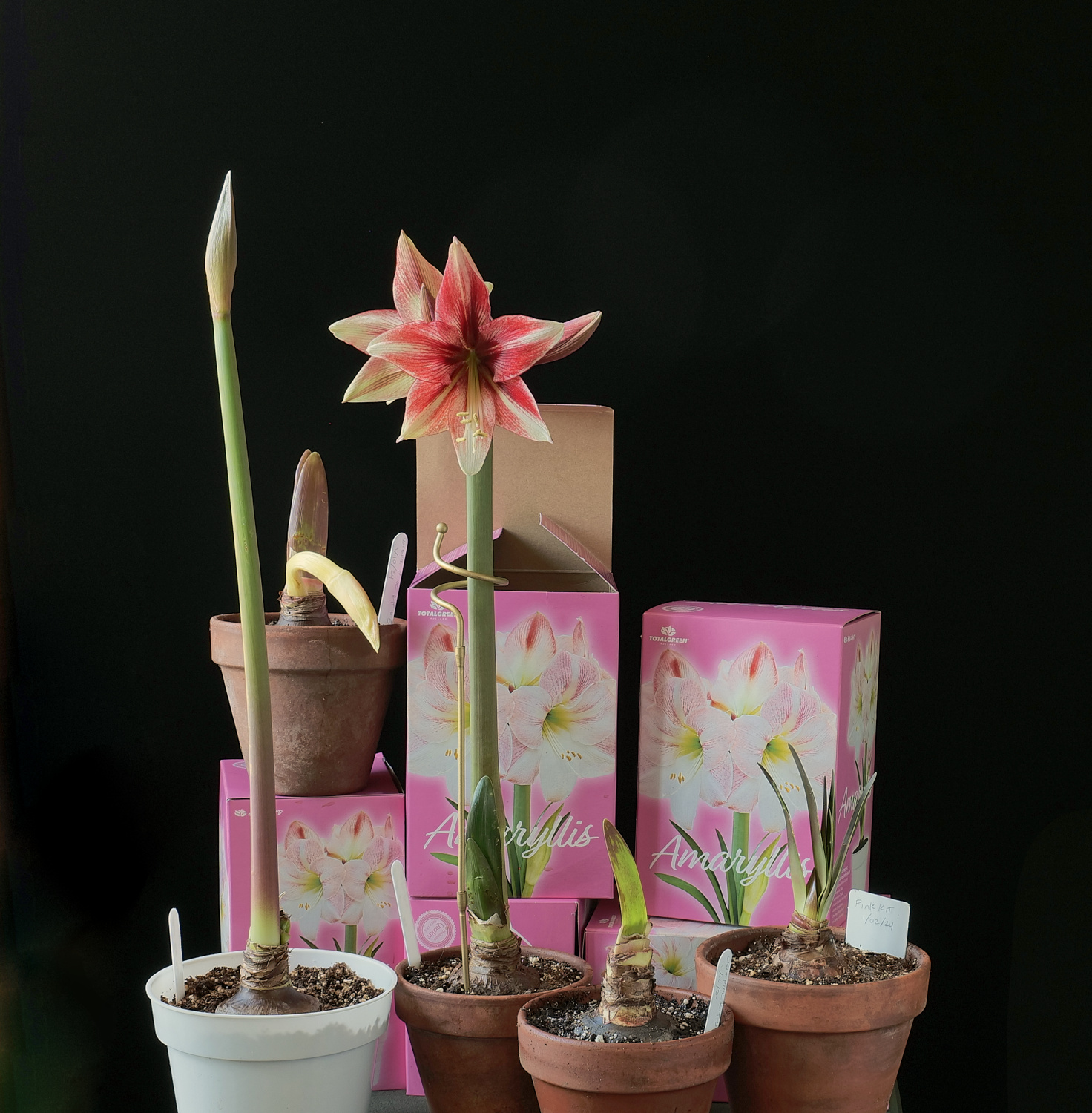
The first of our (5!) “Apple Blossom” kits has bloomed! It’s pretty easy to confirm that all of these bulbs are grown by Saad-Assaf as this is ‘Opal Star’, one of their own hybrids. While not the most robust specimen, it is pretty impressive in that the damaged scape feels firm and the stake is really not needed. Also…we get 6 buds! What about the rest? The tall, dark shaded and handsome scape on the left looks very different from that of ‘Opal Star’ mostly in that purplish lower portion. This is exciting! Will we get 5 completely different varieties?! Very doubtful. But it looks like two at least. Of the first three kits purchased, the one on the right is now pushing a scape among its foliage. This should perform pretty well, it is taking its time and allowing the roots to do their job.
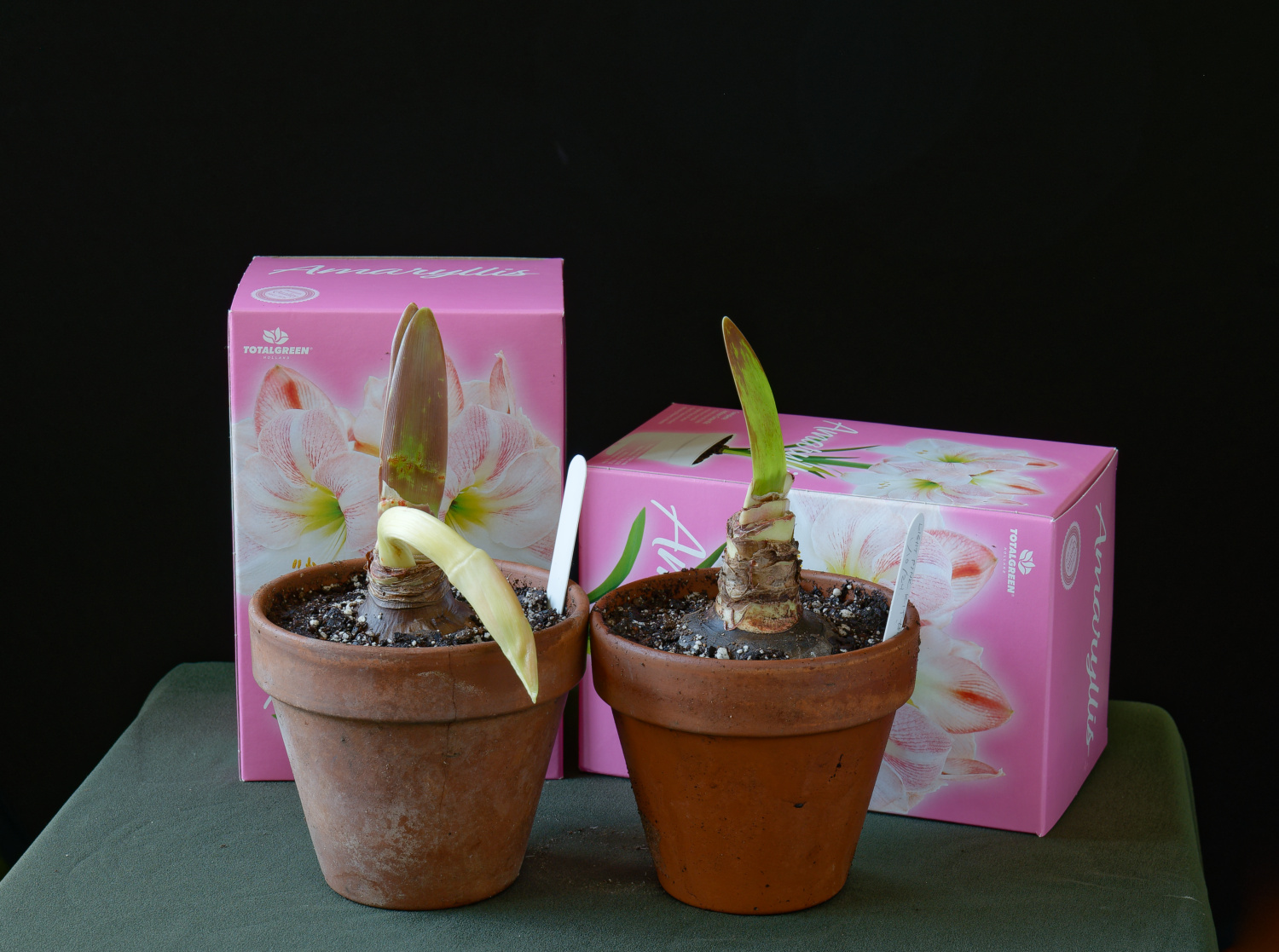
After a couple of days of hydration therapy, our newest bulbs are potted into clay pots and in our in-house potting medium. The flattened and weak scape on left will rely on quick root development if it is to have any chance. The one viable leaf on the other bulb has pigmented well with bright light exposure. The bronzy purple color is protective “sunscreen” for the tender tissue, they will “green up” later. OK, so what about those other kits?
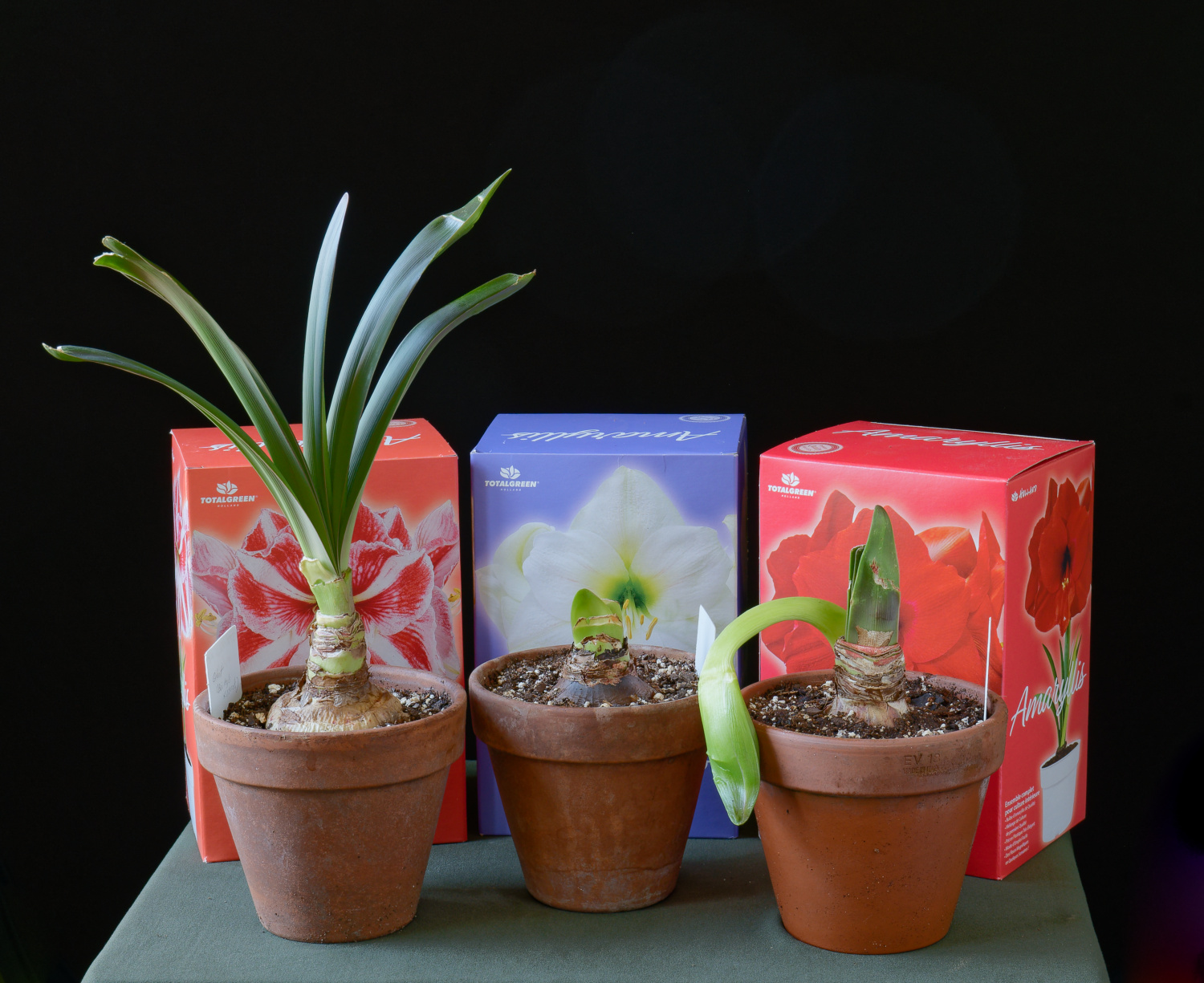
The three kits above are all doing their own thing. Stripe box is all foliage, all the time. No sign of scapes, but we know that with good leaf production comes good root production. If it does make scape(s), they should be tall and healthy. The White box entry is tortoise slow. Maybe it will win the day in the end. The leaves are oh…so…slowly growing. Again, we are betting root production is happening; pacing itself may yield a good final result…if it blooms. Ah, and then there’s Red. That poor, flattened and spongy scape is really struggling. It can’t right itself and may well fail. We would cut it and put it in water if there were any sign that the floral bracts were opening. They are remarkably firm in contrast to the stem below. We’ll only intervene if the bracts (spathe) begin losing turgor. Fingers are crossed. C’mon guys!
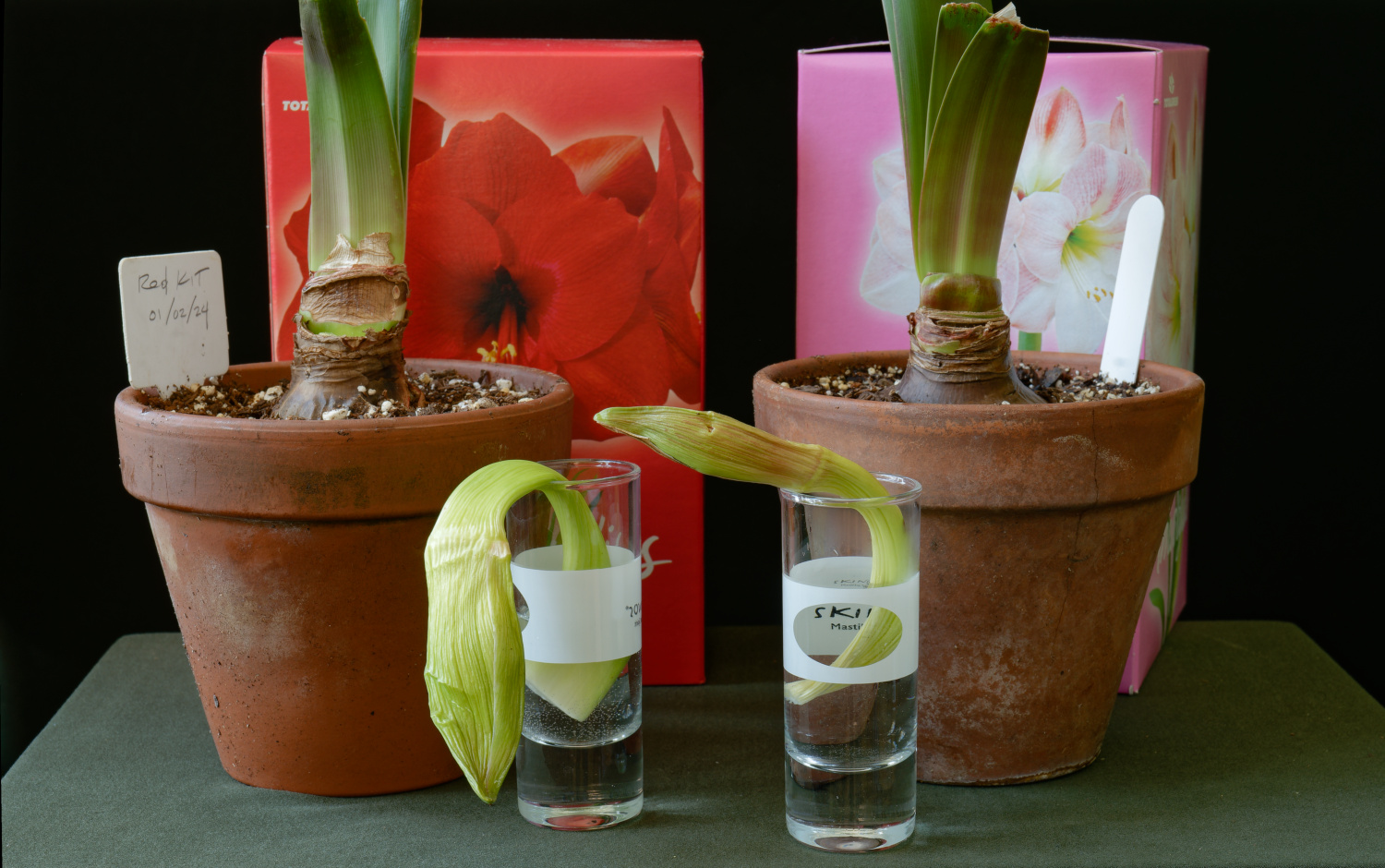
It shouldn’t be too surprising considering the number of kits we have, that some would fail. After deciding to remove the scapes to attempt to hydrate them in water also seemed to be failing, only one option remained: surgery. Let’s see if we can discern any color in the developing buds within these withering scape bracts.
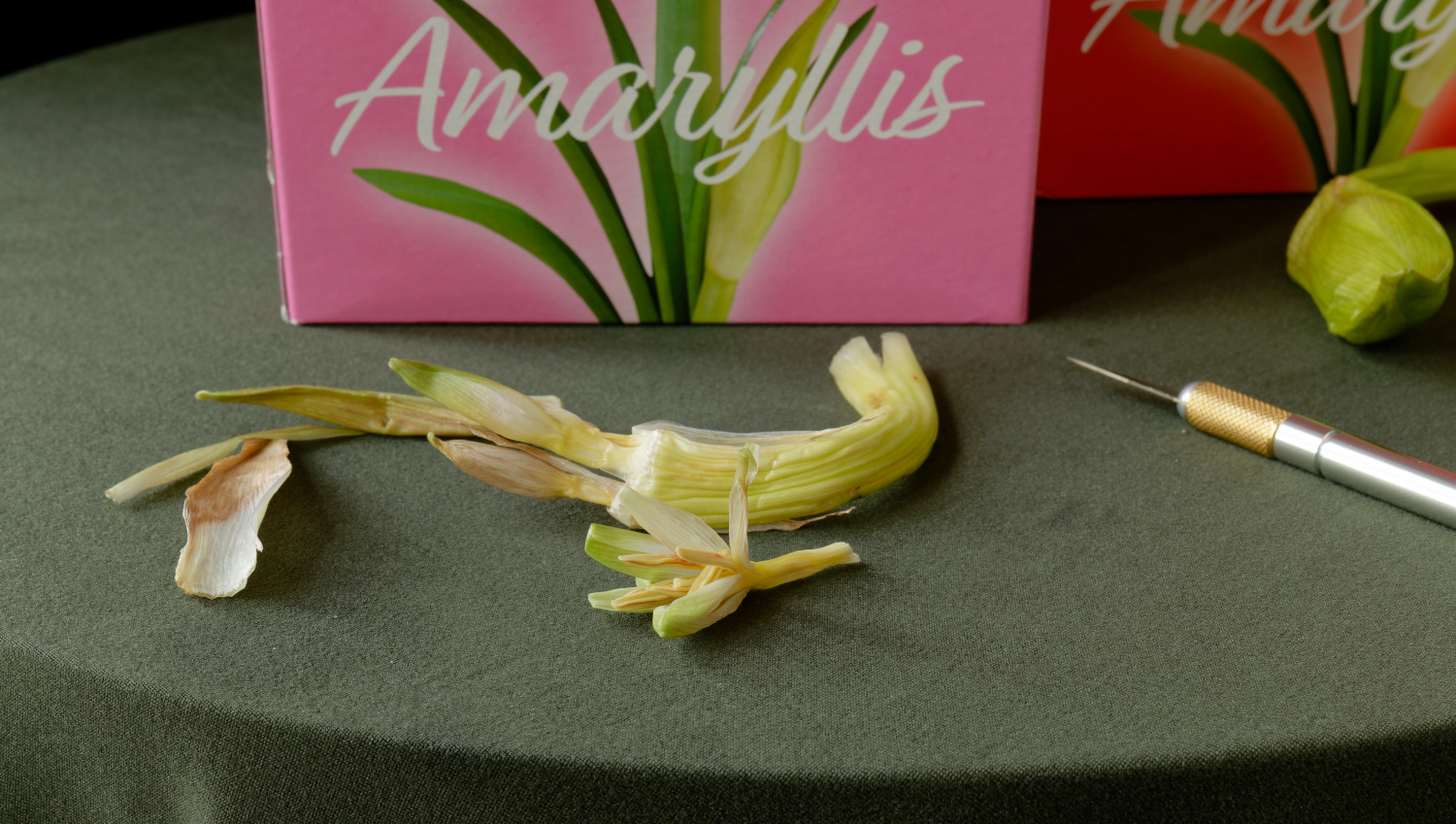
Our pink kit bought January 10 had a flattened and curved scape that never seemed to transport much water into the buds. It’s unlikely that immediate cutting and placing in water would have made any difference. One of the two bracts (or “valves”) had already turned papery towards the tip. Opening the tiny buds only revealed translucent tepals with no pigmentation. Maybe this would have been a white flower? Only if the bulb produces another scape will we know this year. Maybe the red kit scape, which is larger will reveal more. Let’s see.
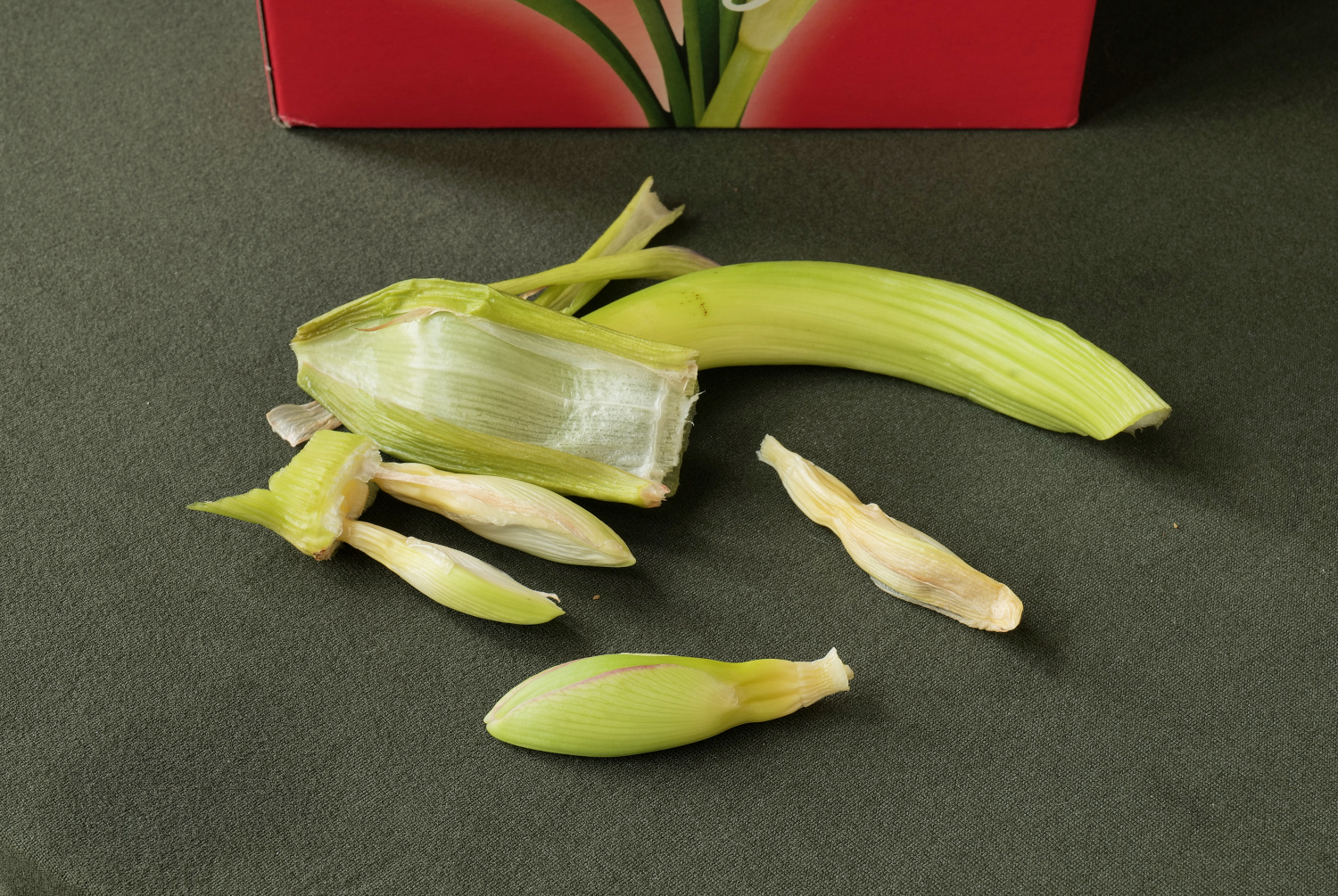
Our red kit has revealed a hint at what we might have here. The pigmented edge of the still green tepals indicate a picotee cultivar; maybe this is Saad-Assaf’s venerable ‘Emerald Dawn’.
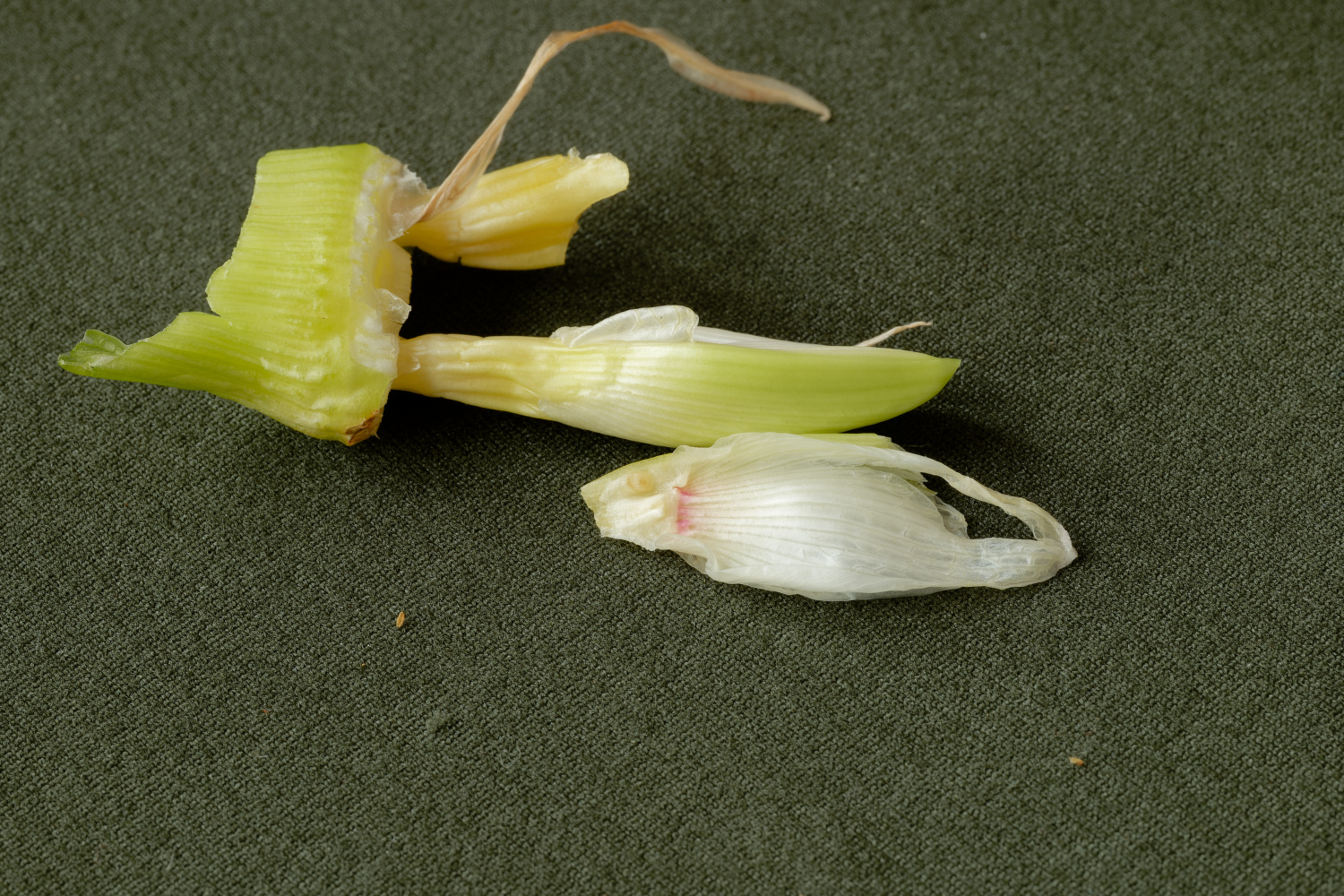
Our surgery reveals another clue, perhaps. A bit of (gulp!) raspberry rose at the base of a tepal, right where it meets the ovary. Many Hippeastrum hybrids show a band of color at the very center, an eye ring as in the case of much our admired ‘Solomon’. One cultivar that does not, is ‘Emerald Dawn’. It’s again doubtful that this little bulb will produce a second scape this season, it will be worth growing this one on for next year. It could be our desired mystery variety! In the meantime…
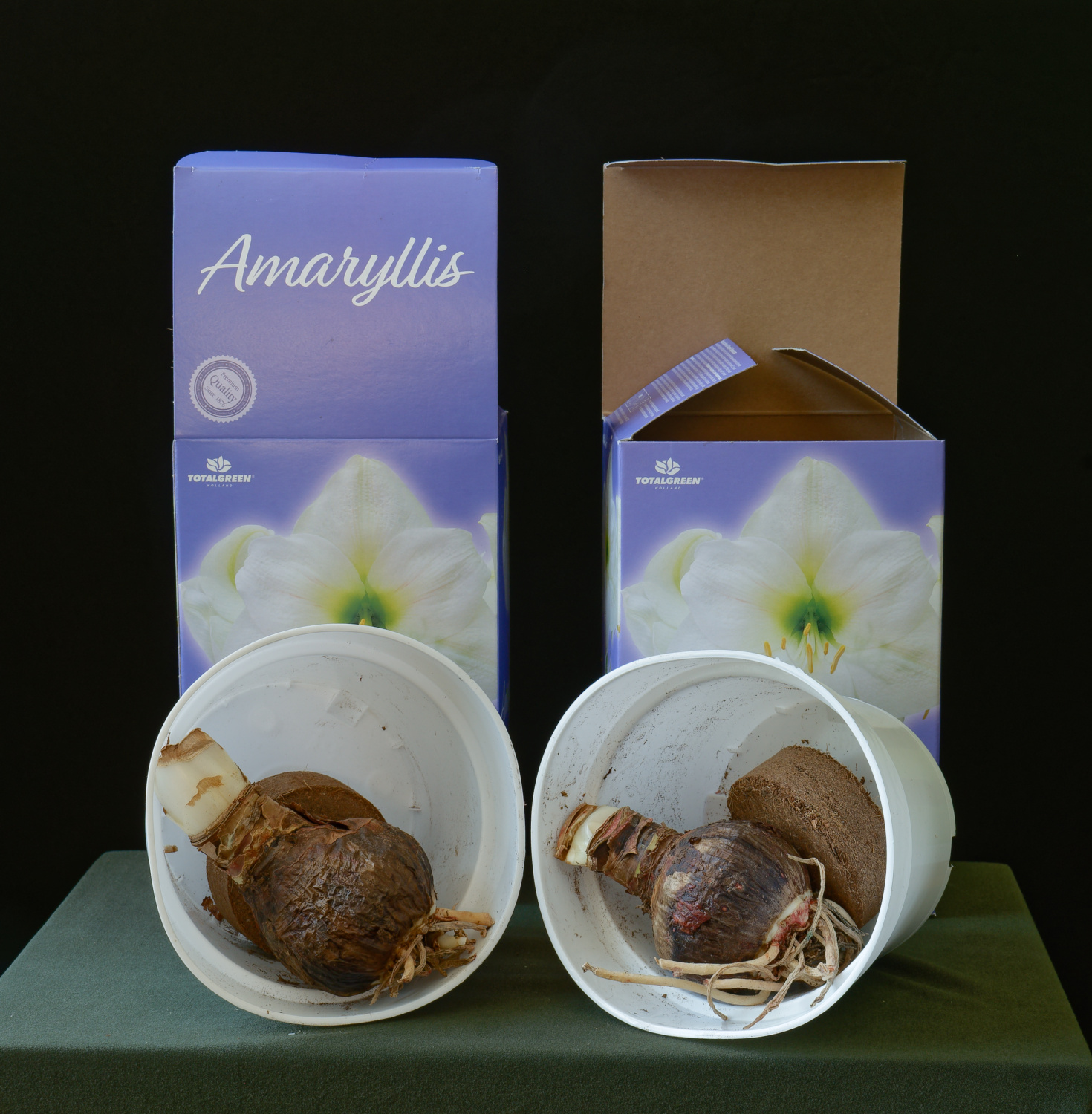
An empty grocery cart. A floral department just as the store is entered. A small shelf of holiday leftovers, both paperwhites and several of these amaryllis kits. A moment of weakness. E is found crouching down, opening all of the remaining box kits to the amused chagrin of the floral department manger. Lots of withered, papery carnage. And two glimmers of hope. These kits contain firm bulbs with little leaf emergence, and no scape emergence. The bulbs both measure a scant 21.5 cm, The roots on one are surprisingly good. They are placed in the grocery cart. Then, off to the produce section. E has to eat to survive, but the flowers are for the soul, and hopefully for our readers!
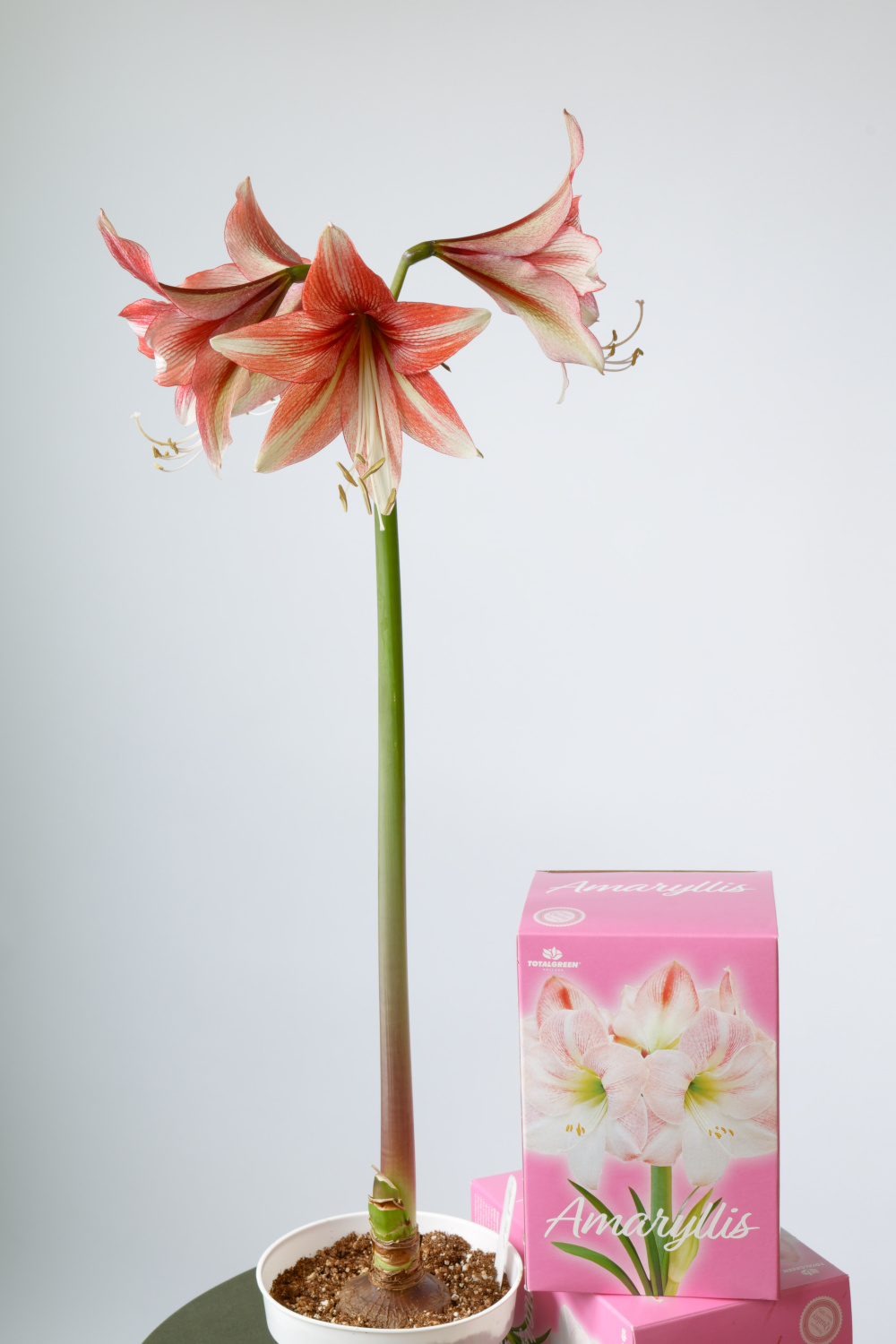
On January 27, after the first (five-flowered) ‘Opal Star’ had faded out, the second one is making a fine show. It “only” has four flowers, but they are larger and open wider. It’s a healthier bulb. One head scratcher…the purplish scape base versus the first one without that coloration revealed nothing, they are the same clone. Emaryllis would have thought that would be a more consistent marker. Apparently, these kits have more mysteries up their sleeves!
Moving on to “Apple Blossom” kit number 3 brings a pleasant surprise. Along with a nice bolt of dark green foliage comes another of Saad-Assaf’s own hybrids. This may be as close as we get to the box photo in that it is truly pink!
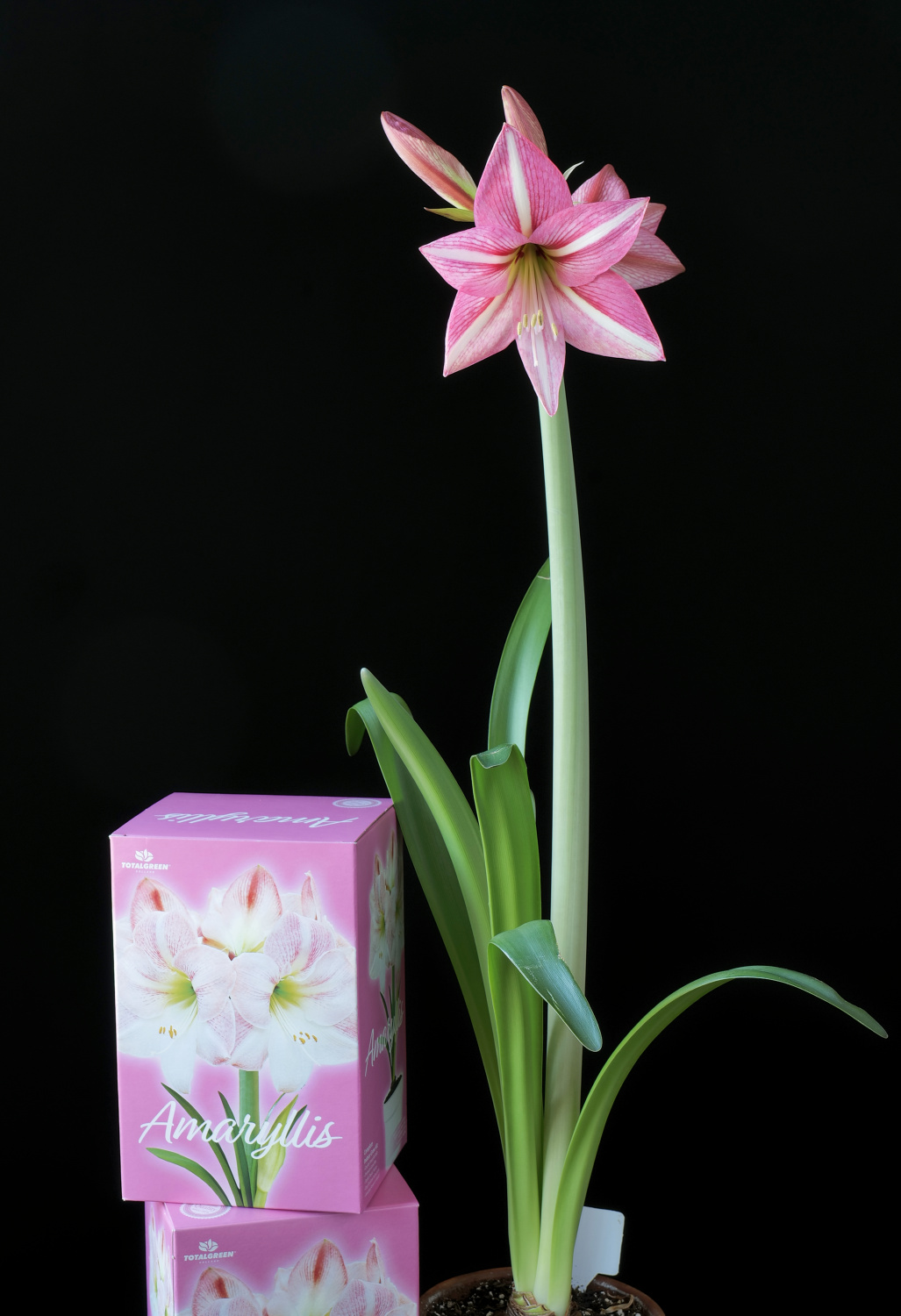
Considering that the previous kits contained the orange-rose ‘Opal Star’, the inclusion of this truly pink variety here brings considerably more praise as a stand-in for the image of ‘Apple Blossom’. It most closely resembles the firm’s ‘Pinkolo’ although the individual flowers seem are larger and fuller in form. In this example we have 5 buds on a tall 59 cm scape, attended by some (slightly wonky) foliage for nice presentation. The flowers open to about 17 cm wide, a bit larger than seen previously for this clone. It is one of the firm’s best pink varieties. The pink is pretty vibrant, and the white midribs add liveliness via contrast. As you know, Emaryllis is a sucker for a bold eye in the middle of this flower, it adds yet more personality. The dark cherry eye practically follows the viewer around the room! Emaryllis is pretty pleased with this one, though the prospects for a second scape look pretty dim. Even with one scape, the bargain price makes it a decent value. Because it looks much like, but not perfectly like ‘Pinkolo’, it will be grown on for bloom next season. Maybe we got an un-named relative!
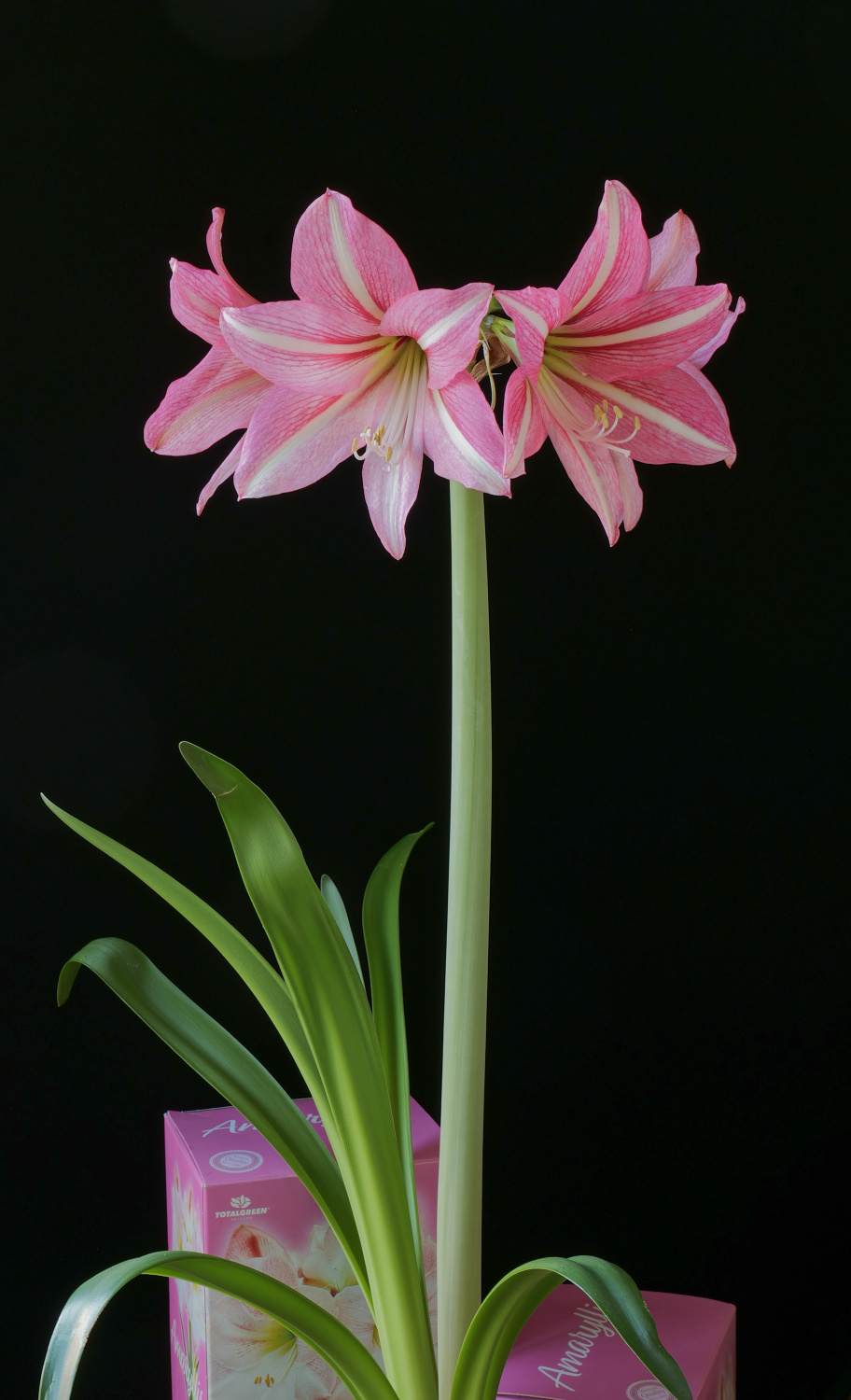
Updated text 25 March, 2024. This one is a mystery, and actually exactly the kind of thing we were hoping for! It looks clearly related to Saad-Assaf’s pink clones like ‘Pink Flush’ and ‘Pinkolo’, especially the latter. But that selection has narrower tepals, and a warmer pink color, blending to some coral tones at the tips. It also has darker scapes. So this one, larger across (17 cm vs. 15 cm flowers), wider tepals, and cooler color…closer to a cyclamen pink. Too many differences to be explained by cultural conditions. Going back to the “Coming Up” page of the grower’s site gives us the answer! We have managed to snag a pre-release copy of an unnamed variety; it goes by only a numeric code at writing. Introducing Saad-Assaf 10-32-1! This is what this post was all about, a glimpse into a breeding program! Perhaps in the next season we will see wide release of this fine clone under a cultivar name.
With the excitement over getting a hybrid direct from the grower pre-introduction still fresh, at least two more kits have yet to reveal their secrets. The two last purchased white box kits are starting to speed along.
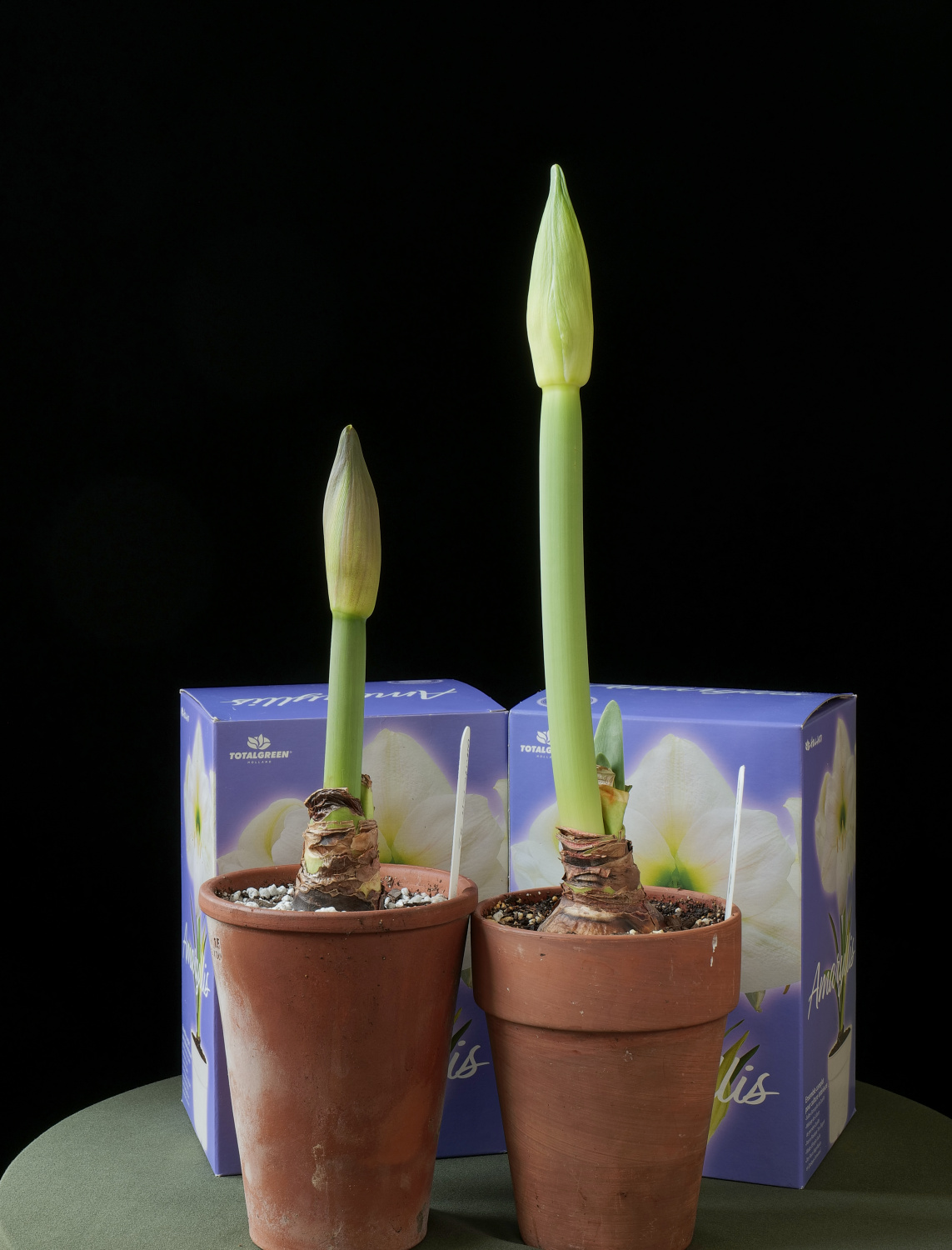
The last kits purchased for this post are at least both producing scapes. A few other kits have only produced foliage, meaning that this post will be getting updates into the 2024/2025 season assuming we can coax them to bloom. But these two hold some mystery that will be revealed very, very soon! The scape above left is deep green, and topped by bronzed spathe bracts. The other, better rooted bulb, has thrust up a pale green scape with matching pale green sheaths. It seems pretty clear that they will not be the same. Will they even be solid white?
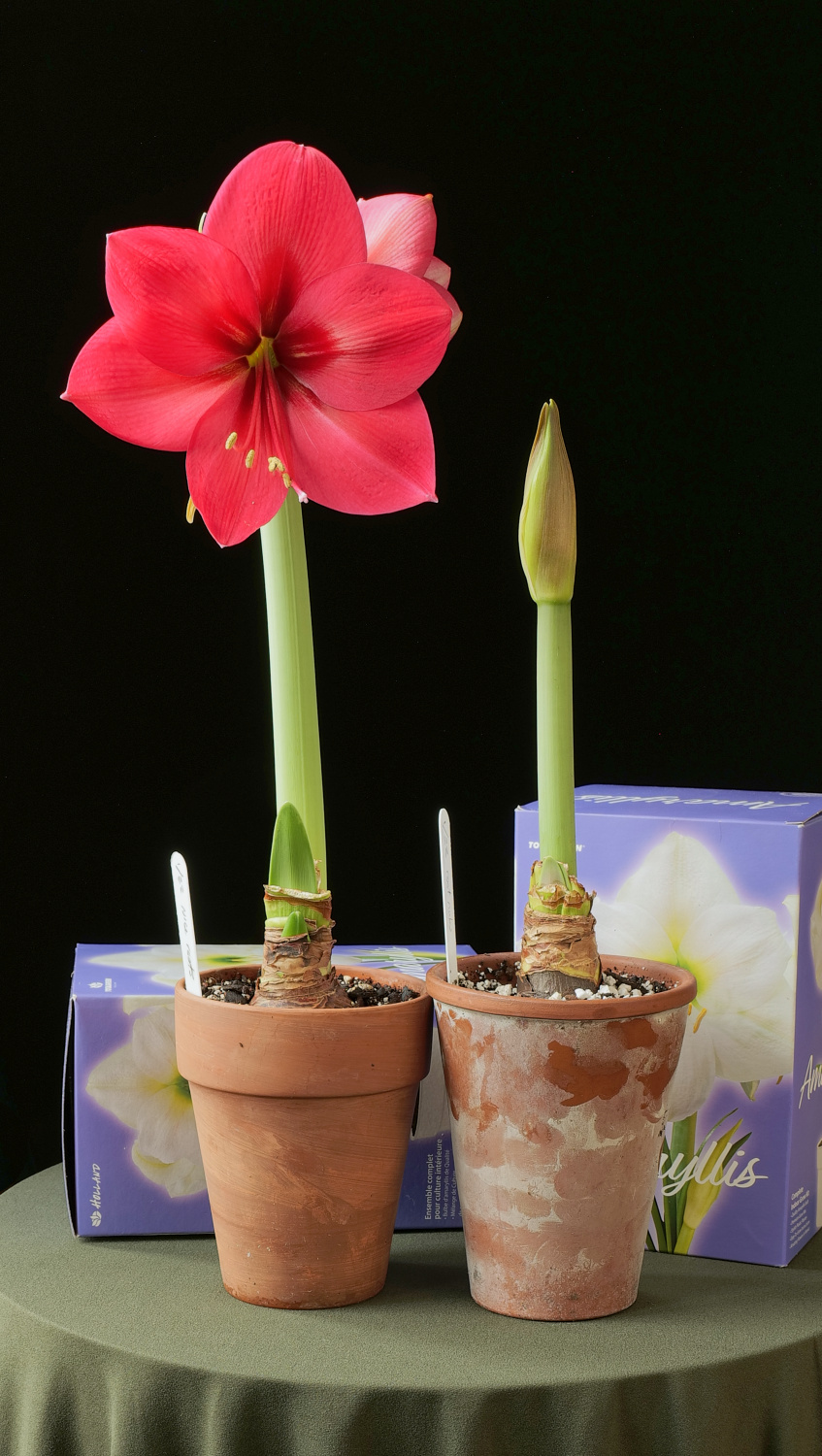
Considering that the grower of these bulbs lists ‘Athene’ and ‘Stella Marris’ as its pure white options, one would think that we would see one of these, or maybe even ‘Jade Mist’. Not so. It looks pretty certain that this time we have ‘Ice Pink’, which is easy in its production run, with only limited retail availability of decent sized bulbs. What to do with bulbs harvested that are too small for dry bulb sales? Put ‘em in a box kit. This isn’t all bad, though. We have 5 buds on that pale scape, and do note the real shocker….a second scape is being produced! Amazing for a bulb under 22 cm. Our other recent purchase is chugging along slowly, tormenting E with mystery she hides. More to come!

That first Amaryllis ‘rescue’ is a beauty! I tend to have the opposite problem, where other varieties end up being Apple Blossom – must be nice to have Apple Blossom turning into other varieties instead. Looking forward to seeing what the others do. I am also addicted to ‘reduced’ plants of any kind, but I figure it’s a cheaper and healthier addiction than most.
It is very common to end up with one of the “big three” no matter what you buy, so it was quite strange to see ‘Opal Star’! The next to bloom should be open in a couple of days, so check back!